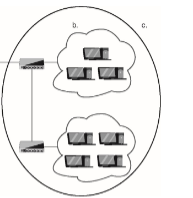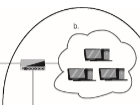Chapter 10: TCP/IP Fundamentals
1/94
There's no tags or description
Looks like no tags are added yet.
Name | Mastery | Learn | Test | Matching | Spaced |
|---|
No study sessions yet.
95 Terms
Range Subnet Mask
1–127 255.0.0.0
Public IP Addresses
Class A
Range:
Subnet Mask:
Range Subnet Mask
128–191 255.255.0.0
Public IP Addresses
Class B
Range:
Subnet Mask:
Range Subnet Mask
192–223 255.255.255.0
Public IP Addresses
Class C
Range:
Subnet Mask:
Range Subnet Mask
10.0.0.0–10. 255.255.255 255.0.0.0
Private IP Addresses
Class A
Range:
Subnet Mask:
Range Subnet Mask
172.16.0.0–172.31 .255.255 255.255.0.0
Private IP Addresses
Class B
Range:
Subnet Mask:
Range Subnet Mask
192.168.0.0–192.168. 255.255 255.255.255.0
Private IP Addresses
Class C
Range:
Subnet Mask:
Address consists of four octets
IPv4
An eight-bit, or one-byte, value
octet
support up to 16 million hosts on each of 127 networks
Class A Network
support up to 65,000 hosts on each of 16,000 networks
Class B Network
support up to 24 hosts on each of 2 million networks
Class C Network
A network within a network
subnetwork
A number similar to an IP address used to determine in which subnetwork a particular
IPv4 address belongs
subnet mask
The address of the computer that provides a connection to the Internet
default gateway address
private company to which domain-name registration privileges are given.
Registrar
private, not-for-profit organization that coordinates the assignment of
domain names and IP addresses.
Internet Corporation for Assigned Names and Numbers (ICANN)
branch of the United States government under the direction of the
Department of Commerce that was responsible for regulating the Internet, overseeing the
issue of domain names, and assigning IP addresses to them
Integrated Network Information Center (InterNIC)
In a DNS structure, .gov is referred to as a
top-level domain
combination of a host name and a domain name,
Fully Qualified Domain Name (FQDN)
In a DNS structure, mit.edu would be
second-level domain
In a DNS structure, faculty.mit.edu would be
subdomain
a software program located on a host that queries a DNS server to resolve a
host name to an IP address
resolver
service that resolves IP addresses to MAC addresses
Address Resolution Protocol (ARP)
system that associates a domain name with an IP address
Domain Name System (DNS)
A service that assigns IP addresses dynamically to a machine when the machine connects
to the network.
Dynamic Host Configuration Protocol (DHCP
protocol that translates private network addresses into an assigned Internet address
Network Address Translation (NAT)
A service that finds the MAC address of a host when the IP address is known.
Reverse Address Resolution Protocol (RARP)
service that resolves NetBIOS names to IP addressess
Windows Internet Naming Service (WINS)
An IP address in the range from 169.254.0.1 to 169.254.255.25
APIPA
Automatically assigning IP addresses
dynamic addressing
An IP address that is issued automatically, typically when the computer boots and joins
the network
dynamic IP assignment
Assigning an IP address manually
static addressing
An IP address that is entered manually for each host on the network
static IP assignment
A number associated with the TCP/IP protocol and used to create a virtual connection
between two computers running TCP/IP
port number
The address 192.168.20.45:80 is an example of
socket
Ports 0 through 1023 are referred to as
well-known number
Ports 1024 and higher are referred to as
upper-level port numbers
Port Number
FTP
20,21
Port Number
SSH
22
Port Number
Telnet
23
Port Number
SMTP
25
Port Number
DNS
53
Port Number
TFTP
69
Port Number
HTTP
80
Port Number
POP
110
Port Number
NNTP
119
Port Number
NTP
123
Port Number
IMAP4
143
Port Number
HTTPS
443
Port Number
SNMP
161
Port Number
RDP
3389
Uses Address Resolution Protocol (ARP)
IPv4
IPSec for security is optional
IPv4
Consists of four octets separated by periods
IPv4
Uses Type of Services (TOS) field in header plus UDP and TCP packets to deliver time-
sensitive data
IPv4
Uses the Neighbor Discovery protocol
IPv6
IPSec for security is mandatory
IPv6
Uses 128-bit addresses
IPv6
Consists of four-digit hexadecimal numbers divided by colons
IPv6
Improved quality of service
IPv6
Contains header information that allows routers to immediately identify the packet
priority
IPv6
MAC address (MAC) or an EUI-64 identifier (EUI-64)
24-bit manufacturer’s ID and 24-bit unique identifier
MAC
MAC address (MAC) or an EUI-64 identifier (EUI-64)
24-bit manufacturer’s ID and 40-bit unique ID
EUI-64
MAC address (MAC) or an EUI-64 identifier (EUI-64)
Modified to fit inside a 64-bit frame
MAC
MAC address (MAC) or an EUI-64 identifier (EUI-64)
The last 64 bits of an IPv6 address
EUI-64

Global

Unique Local

Link Local
anycast address
Delivers packets to the nearest interface and is used mainly for supporting router
functions
multicast address
Delivers packets to multiple addresses
unicast address
Delivers packets to a single network address
starts with 2000: or is written as 2000:/3
global unicast
same function as IPv4 private addresses
site-local unicast
starts with FE80 or FE80::/64
Network Discovery feature requires to function
link-local unicast
unique-local unicast
starts with FC00
127.0.0.1
IPv4 loopback address
(any) 0:0:0:0:0:0:0:1, ::1
IPv6 loopback address
0.0.0.0
IPv4 unspecified address
0:0:0:0:0:0:0:0
IPv6 unspecified address
224.0.0.252
IPv4 multicast destination address
ff02::1:3
IPv6 multicast destination address
An IPv6 transition mechanism that provides a means of communicating across the IPv4
Internet while preserving the original IPv6 assigned address of the network device
6to4
node-to-node and node-to-router technology used for existing IPv4 network devices to
eliminate the need to upgrade these devices
ISATAP
network address translator that creates a tunnel that allows incoming IPv6 traffic
through a firewall designed for IPv4
Teredo
Lists IP addresses resolved to MAC addresses
arp
Displays the TCP/IP settings on a UNIX/Linux computer
ifconfig
Displays the TCP/IP settings on a Windows 2000 and later computer
ipconfig
Displays NetBIOS over TCP statistics
nbtstat
Displays current TCP/IP and port statistics
netstat
An advanced ping utility that displays all the hops from source to destination
tracert
Queries domain servers and shows domain names and IP addresses
nslookup
Queries domain servers to obtain information about domain names and IP addresses
nlslookup
Sends a packet from one host to another on a network and then echoes a return reply
ping
Provides detailed information about network traffic
tcdump
Displays the approximate hop lapse times between points along a route
traceroute/tracert